Executive Summary
Contract management has evolved from a back-office function to a critical strategic capability that directly impacts organizational performance and competitive advantage. Our comprehensive analysis, enhanced with authoritative Deloitte research and collaborative industry studies, reveals that organizations experience an average of 8.6% value erosion due to poor contract management, while the global CLM market is projected to reach $12 billion by 20252.
This represents a modest improvement from the 9.2% value erosion identified in 2014, indicating that despite significant technology investments, substantial opportunities for improvement remain. Leading organizations achieve value erosion rates as low as 3%, while underperforming organizations experience erosion exceeding 20%—demonstrating the critical importance of contracting excellence1.
Key Headlines for 2025:
– 8.6% average value erosion with best performers achieving 3% and underperformers exceeding 20%1
– 78% of organizations invested in CLM over the past five years1
– 26% of workforce actively involved in contracting processes1
– Contract data fragmented across 24 different systems on average1
– 84% of organizations expect globally standardized contract templates by 20253
– CLM market growing at 12-15% annually with strong investment momentum4
Market Size & Growth Projections
Global Market Expansion
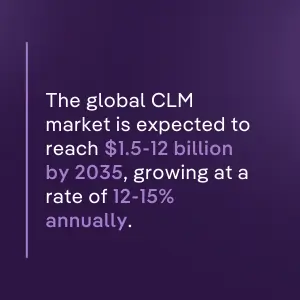
The contract lifecycle management market demonstrates exceptional growth potential across multiple forecasting methodologies:
- 2025 Market Size: $1.5-$12 billion depending on scope and methodology2,5
- Annual Growth Rate: 12-15% CAGR indicating robust market expansion4
- Investment Momentum: 78% of organizations made CLM investments in the past five years1
- Recent Activity: 41.9% implemented investments within the last year1
This growth reflects increasing recognition that contract management represents a strategic capability rather than merely an administrative function.
Technology Adoption Acceleration
Digital Transformation Momentum:
- 74% of legal departments now use contract management software6
- 84% expect globally standardized contract templates3
- 60% of legal functions ready to adopt new technology3
- 73% don’t view conservatism as barrier to digital adoption3
Investment Landscape
Legal Technology Spending:
- Average legal tech spend: $1.2 million per department6
- 56% actively investing in efficiency technology3
- 75% believe legal can contribute significantly to corporate strategy3
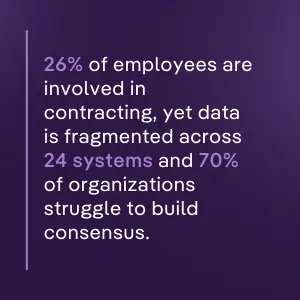
Contract Value Leakage & Financial Impact
Organizational Impact and Process Costs
Workforce Involvement and System Complexity:
- 26% of the typical workforce participates in contracting processes1
- Contract data fragmentation: Organizations maintain data across an average of 24 different systems1
- Stakeholder consensus challenges: 70% of organizations struggle to build agreement across stakeholders1
- Cross-functional coordination: Critical for managing complex contracting lifecycles1
- Performance spread: 17+ percentage point gap between best and worst performers1
Financial Impact of Inefficiency:
- Poor collaboration: Costs organizations $140 billion annually7
- Dispute resolution: $870 billion spent globally each year7
- Administrative overhead: Significant cost reduction opportunities through process optimization1
Contract Development Cost Analysis
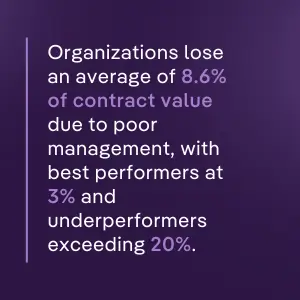
Research reveals significant cost variations based on contract complexity:
- Standard templates (no negotiation): $6,000-$12,0001
- Mid-complexity transactions: $50,000-$100,0001
- Custom contracts requiring external advisors: $150,000-$200,000+1
Sector Impact Variations:
- Consumer goods companies: Combined contracting costs and value loss represent 2-4% of revenue1
- Capital project sectors: Impact can exceed 15% of revenue due to high-value, complex agreements1
- Service-based industries: Increasing complexity as business models shift toward outcome-based contracts1
AI Adoption in Contract Management
AI Performance and Implementation
Current AI Capabilities:
- AI contract review speed: 26 seconds versus 92 minutes for human review7
- AI accuracy rate: 94% in NDA review tasks7
- Automation potential: Legal teams can achieve 82% time savings on contract tasks2
- Performance advantage: AI consistently outperforms human lawyers in both speed and accuracy for routine tasks7
Adoption Integration Status:
- Full AI integration: 21% of organizations have achieved comprehensive integration7
- Formal AI governance: 31% have established policies and procedures7
- Implementation gap: Despite proven benefits, majority of organizations lag in deployment7
Digital Readiness Assessment
Based on Deloitte’s global survey of 300 legal department executives:
- Awareness levels: 85% are informed about available legal technology tools3
This data reveals a significant gap between readiness and action, indicating substantial untapped potential for technology adoption.
Future Technology Integration
Strategic Evolution Indicators:
- Organizational visibility: 72% report having tools that provide organization-wide contract and risk management views3
- Cross-functional collaboration: 86% believe their data platforms facilitate collaboration across business functions3
These projections suggest fundamental changes in how legal departments operate and contribute to organizational success.
Operational Efficiency & Process Statistics
System Integration and Data Management
Current Infrastructure Challenges:
- Integration complexity: Multiple departments using disparate tools and processes1
Investment Priorities and Outcomes:
- Technology focus: 65% of CLM investments target technology solutions1
- Process simplification: 46% focus on streamlining workflows1
- Achieved benefits: 48% report improved contract data visibility and management1
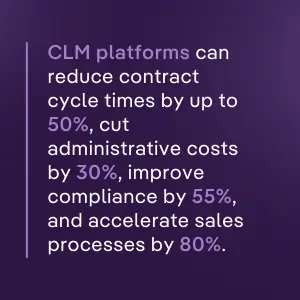
Measurable Performance Improvements
Efficiency Gains Through Technology Implementation:
- Contract cycle time reduction: 30-50% improvement possible with comprehensive CLM platforms4
- Administrative cost savings: 25-30% reduction through process automation7
- Compliance enhancement: 55% improvement through contract digitization7
- Sales process acceleration: 80% faster turnaround with integrated contract tools7
These metrics demonstrate tangible returns on CLM technology investments when properly implemented and adopted.
Industry-Specific Insights
Sector Performance Variations
Value Erosion by Industry:
- Technology and software: High complexity, variable impact1
- Financial services: Leading in digital adoption3
Investment Patterns by Sector
Technology Adoption Leadership:
- Financial services: Highest investment in legal technology3
- Technology sector: Leading AI integration experiments3
- Manufacturing: Significant process automation focus1
- Healthcare/Pharma: Above average in data visibility benefits1
Regional and Market Dynamics
Global Implementation Trends:
- North America: Leading market adoption6
- European compliance: Driving standardization needs1
- Asia-Pacific: Emerging technology integration6
Contract Management Challenges
Process Complexity Issues
Organizational Friction Points:
- Multiple system integration requirements1
Technology Implementation Barriers
Adoption Challenges:
- Change management across diverse stakeholder groups1
Performance and Value Gaps
Execution Challenges:
- Technology potential vs. reality: Investment doesn’t guarantee results1
- Skills and capability alignment critical for success1
Future Trends & Implementation
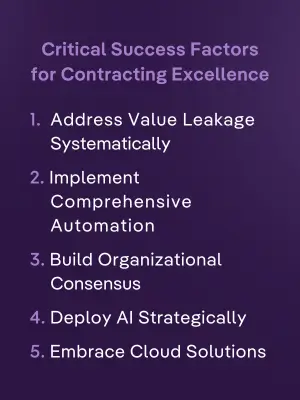
Technology Integration Trajectory
Digital Transformation Evolution:
- AI integration accelerating across all business functions8
- Hardware infrastructure becoming strategic again8
Market Growth Projections
Investment and Expansion:
- Technology spending increasing across legal departments3
- Integration focus driving next wave of improvements1
Operational Evolution
Process Transformation:
- Global standardization becoming industry norm3
References
- WorldCC Research Library – Contract Management Performance Studies Note: Specific ROI report data sourced from WorldCC collaborative research with Deloitte
- Procurement Tactics – Contract Management Statistics
- Deloitte Legal Business Services – Digital Transformation Research Note: Data from global legal executive survey
- The Business Research Company – Contract Management Software Global Market Report
- Future Market Insights – Contract Lifecycle Management Market
- Epiq Global – Legal Technology and Operations Insights
- B2B Reviews – Contract Management Statistics
- Deloitte Tech Trends 2025 – Main Portal


